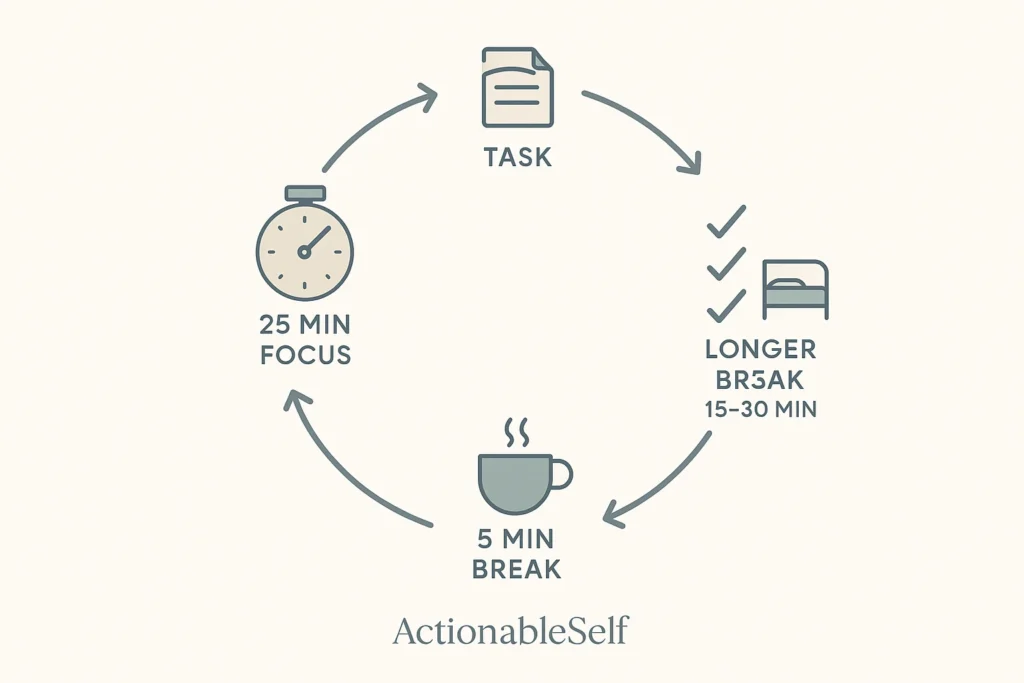In a world of constant digital distractions, the ability to focus on a single task is a modern-day superpower. Our attention is pulled in a thousand different directions, leaving us feeling busy but not productive.
But what if you could train your focus in just 25 minutes? What if there was a simple, proven system to beat procrastination, manage distractions, and get your most important work done without burning out?
That’s the simple but profound promise of the Pomodoro Technique.
Developed by Francesco Cirillo in the late 1980s, this time management method is not about working longer hours; it’s about working smarter by using a timer to break down work into focused intervals, separated by frequent, short breaks.
This guide will break down exactly what the Pomodoro Technique is, the science behind why it’s so effective, and a step-by-step plan to implement it today and reclaim your focus.

What is the Pomodoro Technique? The 5 Simple Steps
The Pomodoro Technique is a cyclical system. You work in short sprints, which ensures you’re consistently productive, and you take regular breaks, which prevents mental fatigue. The entire process is beautifully simple.

- Choose ONE Task: Pick a single, specific task you want to work on. Ambiguity is the enemy of focus, so be clear about your objective for the next 25 minutes.
- Set a 25-Minute Timer: This focused work block is your first “Pomodoro” (the Italian word for tomato, named after the tomato-shaped timer Cirillo originally used).
- Work with Undivided Focus: For the next 25 minutes, your entire world is this one task. No checking email, no scrolling social media, no getting up for a snack. If a distraction or a new idea pops into your head, quickly write it down on a notepad and immediately return to your task.
- Take a Short Break: When the timer rings, you’ve completed one Pomodoro. Put a checkmark on a piece of paper and take a mandatory 5-minute break. It’s crucial that you actually take this break. Get up, stretch, get some water, or look out the window. Do something completely unrelated to your work.
- Repeat and Take a Longer Break: After you’ve completed four Pomodoros (and have four checkmarks on your paper), you’ve earned a longer, more restorative break of 15-30 minutes. This is your time to truly recharge before starting the next cycle.
That’s it. That’s the entire system. Its simplicity is its strength.
The Science Behind Why It Works So Well
The Pomodoro Technique is so effective because it’s not just a productivity hack; it’s a system built on sound psychological principles.

- It Combats Procrastination by Lowering the Barrier to Entry: The biggest reason we procrastinate is that a task feels too big or overwhelming. The thought of “writing a 10-page report” is intimidating. But the thought of “working on the report for just 25 minutes” is not. The Pomodoro Technique makes it incredibly easy to start, and starting is almost always the hardest part.
- It Improves Focus by Creating Urgency: The ticking timer creates a sense of positive pressure. It’s not the stress of a looming deadline, but the gentle urgency of a contained sprint. This helps you resist the temptation of “just quickly checking” your phone, because you know you have a dedicated break coming up soon. It trains your brain’s “focus muscle.”
- It Prevents Burnout by Forcing You to Rest: In our “hustle culture,” we often see breaks as a sign of weakness. The science is clear: our brains are not designed for 8 hours of continuous, focused work. The short, regular breaks are not optional; they are a core part of the system. They allow your brain to rest, consolidate information, and maintain a high level of performance throughout the day.
- It Gamifies Your Work and Builds Momentum: The simple act of completing a Pomodoro and putting a checkmark on a piece of paper creates a powerful, positive feedback loop. Each checkmark is a small win. It provides a tangible sense of accomplishment and progress, which builds motivation and makes you eager to start the next sprint.
This technique is one of the most powerful tools in our guide on How to Beat Procrastination.
How to Implement the Pomodoro Technique: Best Practices
Getting started is easy, but mastering the technique involves a few best practices.

Choosing the Right Tools
You don’t need fancy software. The beauty of the system is its flexibility.
- Low-Tech (Recommended for Beginners): A physical kitchen timer and a piece of paper. The physical act of winding the timer and making a checkmark can be very satisfying and reinforcing.
- Your Phone’s Timer: Simple and always with you. Just be sure to put your phone on “Do Not Disturb” mode to avoid temptations.
- Web-Based Timers: Websites like Pomofocus.io are great because they are simple, clean, and accessible from any browser.
- Dedicated Apps: Apps like Forest (which gamifies focus by growing a virtual tree), Be Focused, or Focus Keeper offer more advanced features like statistics and task management.
Handling Interruptions Like a Pro
Interruptions are inevitable. The key is to have a plan for them.
- Internal Interruptions (Your own thoughts): An idea for another project or a task you forgot pops into your head. Don’t act on it. Quickly write it down on your notepad under a heading like “To Do Later.” Then, immediately return to your Pomodoro task. This acknowledges the thought without letting it derail your focus.
- External Interruptions (Other people): A colleague comes to your desk to ask a question. Use the “Inform, Negotiate, Reschedule” strategy.
- Inform: “I’m in the middle of a focused work block right now.”
- Negotiate: “Can we talk about this in about 15 minutes when I’m on a break?”
- Reschedule: “Let’s connect at 2:30 PM.”
Adapting the Timers to Your Brain
The 25/5 minute interval is the standard recommendation and the best place to start. However, it’s not a sacred rule. Once you’ve used the standard method for a week or two, you can experiment to find what works best for your brain and the type of work you do.

- For highly creative or complex tasks: You might find you need longer to get into a state of “flow.” Try a 50/10 interval (50 minutes of work, 10 minutes of break).
- If you have a very short attention span: Start with a 15/3 interval (15 minutes of work, 3 minutes of break) to build your focus muscle.
The goal is to find a work interval that is long enough to make meaningful progress but short enough that you can maintain 100% focus.
The Pomodoro Technique is a powerful tactic. Learn how to fit it into a larger strategy in our Ultimate Guide to Mastering Productivity.
Conclusion: Reclaim Your Focus, 25 Minutes at a Time
The beauty of the Pomodoro Technique lies in its simplicity. It’s a system that anyone can start using in the next five minutes with nothing more than a timer and a piece of paper.
It’s a powerful reminder that significant progress and deep, meaningful work are not the result of heroic, all-night marathon sessions. They are the product of small, consistent, and focused sprints, compounded over time.
Your challenge is simple: pick one important task you’ve been putting off. Set a timer for 25 minutes. Turn off your notifications. And just begin.
Have you tried the Pomodoro Technique? Share your experience or your favorite Pomodoro app in the comments!


